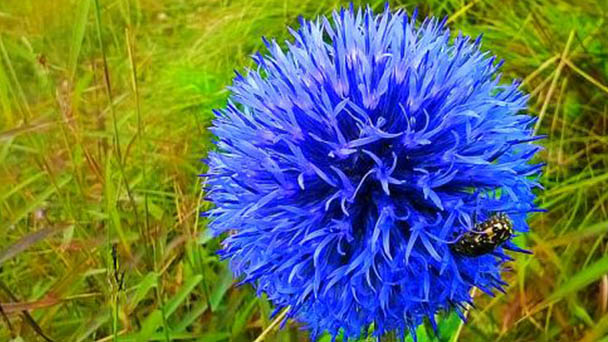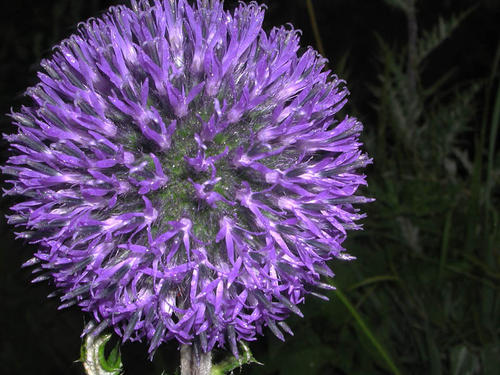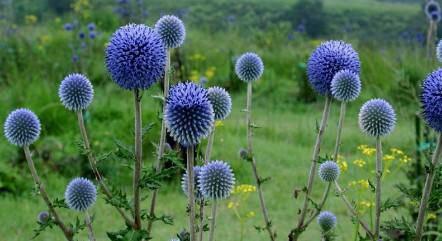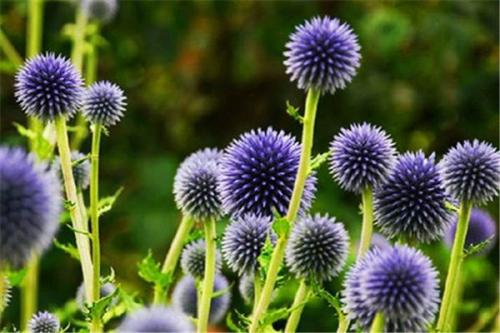Globe thistle (Echinops sphaerocephalus) profile
Written by Maggie
Mar 24 2021

Globe Thistle (Echinops sphaerocephalus L) belongs to the genus Globe Thistle in Compositae, distributed in Eastern Europe, Africa to Asia and about 10 species in China, mainly from northwest to northeast. Globe Thistle is stout, some thistle-like, stem and back of leaves somewhat covered with white woolly hairs; Leaves are alternate, often pinnately toothed or deeply lobed, teeth and lobes spiny;Inflorescences with 1 floret each; The involucral bracts consist of spiny outer bracts and linear or lanceolate inner bracts, all flowers aggregating into a dense, globose complex head with leafy bracts drooping at the base of the inflorescence; Achene is elongate, tetra-prismatic or cylindrical, often pubescent, apically with many short scales. It is a kind of excellent nectar source plant and has medicinal value.
Globe thistle picture

Globe thistle info
| Botanical Name | Echinops sphaerocephalus |
| Common Names | Globe thistle |
| Plant Type | Perennial |
| Sun | Full sun |
| Hardiness Zones | USDA growing zones 3-9 |
| Flower color | Blue, purple, and white |
| Native Area | Central Asia; Southeastern and South central Europe |
| Mature size | 2 to 5 feet |
Morphological characteristics of globe thistle
Stems
Globe Thistle is a perennial herb, 50-150 cm tall. Stem is solitary, upper branches long or short, stout, all stem branches densely multicellular long hairs and sparse spider-like thin hairs.
Leaf
Stems and leaves of basal and lower parts of Globe thistle fully lanceolate, 15 -- 25 cm long and 5 -- 10 cm wide, pinnately cleft, lateral lobes 3 -- 5 pairs, triangular or lanceolate, margin acuminate, apex needlelike acuminate, upper leaves tapered, isomorphic with basal leaves and lower stems and leaves. All leaves are thin, papery, heterochromatic on both surfaces, green above, densely short strigose, grayish below, covered with thin spider silk woolly, but with multicellular long nose hairs along my veins.
Flowers
Globe thistle is the apex of a single stem with a complex head, 4 -- 5.5 cm in diameter. Inflorescences are 2 cm long. Basal hairs are 1 cm long, half of involucre length, white, oblate, unequal. Outer bracts are slightly longer than basal hairs, oblanceolate, distally elliptic, brown, outer covered with slightly dense short strigose and glandular spots, margin with slightly longer ciliate, apical needle-like long acuminate, lower pawl with long ciliate up to 4 mm; Medial bracts are oblanceolate or oblong-elliptic, ca. 1.1 cm long, margin ciliate, outside densely short hispid; Innerlayer is lanceolate, 8 mm long, outside by dense short strigose, top awn tooth crack or awn slice crack, middle awn crack is longer. Florets of Globe Thistle are pale blue or white, corolla 5-lobed, lobes linear, corolla tube without or sparsely glandular spots.
Fruit
Achene of Globe Thistle is obconical, ca. 7 mm long, covered with yellow dense appressed straight hairs, not covering crown. Crown hairs are cup-shaped, ca. 1.2 mm tall; Coronoid diaphragm is linear, margin strigose, mostly connate.
The ecological habits of globe thistle
Globe Thistle has strong adaptability, drought resistance, barren resistance, cold resistance, like cool climate and sandy soil with good drainage, avoid heat, wet and waterlogging, can be extensive management. It is a good summer flower type perennial root flower.
Globe thistle propagation
Globe Thistle can be propagated by seed propagation, root cuttage and tissue culture.
How to grow and care for globe thistle
Light
Globe thistle plant life wants a full day of solar to stay compact and bloom well. If used as a section of a basis border, plant them on the east or south aspect of the home.
Soil
Good drainage is essential for healthful globe thistle plants. The flora tolerate dry and rocky soils. In areas with heavy clay, use raised beds to enhance drainage or plant in containers.
Water
The lengthy taproot of globe thistle allows them to live to tell the tale of drought conditions. Water newly planted globe thistle weekly, in the first month to assist them get established, then solely water if flora exhibit symptoms of drought stress, like browning of foliage.
Temperature and humidity
Globe thistle thrives in hot, dry areas. In areas of excessive humidity, grant ideal plant spacing and a function in full solar to forestall mildew.
Fertilizer
No fertilizer is fundamental for the globe thistle. Plants might also flop in stipulations of too plenty fertility and require staking.

Pruning
Cut away the spent plant life to add to dried flower arrangements, to forestall reseeding, and to motivate re-bloom. Cut useless flowers down to floor level in late winter.
Repotting
Growing in containers is one way to manipulate globe thistle vegetation when they show off invasive qualities. Plant them in mixture with different xeriscape vegetation that add contrasting shade and softer textures, like yarrow or lavender cotton. If you desire flora to return to the subsequent developing season, they have to be at least two zones harder than your area, to face up to the deep freezing that happens in containers.
The lengthy faucet root of the globe thistle provides some potting and repotting challenges. It's first-rate to pick out a giant pot for an everlasting domestic for new globe thistle transplants. Choose a sandy loam or cactus potting soil for the plants. Repot solely if vegetation wants to be divided.
Overwintering
After your globe thistle has stopped blooming, reduce to basal foliage and go away be until subsequent season.
Globe thistle pests & diseases
Insect pests take benefit of negative developing stipulations for globe thistle, like moist spring weather. In this case, you may also take a look at aphids or the four-lined plant bug. Cosmetic harm is minimal, and decreases as the climate warms, so spraying is now not needed.
Globe thistle varieties
'Arctic Glow': White blooms distinction with reddish stems and silver leaves in late summer.
'Vetch's Blue': Dark blue plant life distinction with curving grayish-silvery stems.
'Taplow Blue': Steely-blue flower heads take a seat atop leafy stems; this range has 5-foot stalks that are ideal for the again of the border.
The distribution of globe thistle
Globe Thistle is distributed in Tianshan Mountains, Xinjiang.On the edge of hillside forest or canal. Globe Thistle is widely distributed in Soviet Union (Central Asia, Caucasus, Siberia), Central and South Europe.
In Europe, some species of Globe Thistle have been widely cultivated as ornamental plants, a few annual species have certain medicinal value, some species can be used as nectar plants, and some species contain alkaloids, which are toxic to livestock.
Globe Thistle uses
Dried flowers
Globe Thistle can be used as both fresh cut and dried flowers. It can be used in the decoration of flowers in families, hotels and restaurants because of its peculiar flower type, gorgeous and rich color and long ornamental period. After its cut flowers are listed, they are favored and recognized by consumers, especially foreign friends, and are expected to enter the international market.
Landscape use
Globe Thistle is a wild flower endemic to high-altitude steppe and mountainous areas. After its introduction, it shows extensive management, strong adaptability and low maintenance cost. Moreover, it has high ornamental value, such as gorgeous and rich flowers and unique inflorescences, so it has a very broad application prospect in landscaping.

Latest Updated
- Benefits of Bugleweed - 7 Science-backed Health Benefits
- Bugleweed Dangers & Side Effects - Is It Poisonous?
- How to Plant Evergreen Trees - What You Should Know
- When to Plant Evergreens - Grow Guide for Evergreen Trees
- 12 Wonderful Evergreen Shrubs for Your Garden
- 12 Popular Evergreen Plants with Pictures for Beginners
- When And How To Prune A Lilac Bush Like a Pro
- How to Grow & Care for Lilac Vine (Hardenbergia Violacea)
- Japanese Lilac Tree (Syringa Reticulata) Care & Propagation Guide
- Shumard Oak Pros and Cons - What to Know
Popular Articles
- Winter maintenance of Antirrhinum Majus
- How to Grow Terminalia Mantaly Tree
- How to Grow and Care for Crossostephium Chinense
- How to grow Antirrhinum Majus in spring
- Peristeria Elata (Dove Orchid) Profile: Info & Care Guide
- Underwatered Snake Plant (Sansevieria Trifasciata) - Signs And How To Fix
- How to Care for Brazilian Jasmine Plant (Mandevilla Sanderi)
- How to Grow & Care for Graptopetalum Purple Delight in Summer
- Rosa Chinensis (China Rose): Plant Growing & Care Tips
- How to Care for Baby Sun Rose (Aptenia Cordifolia)